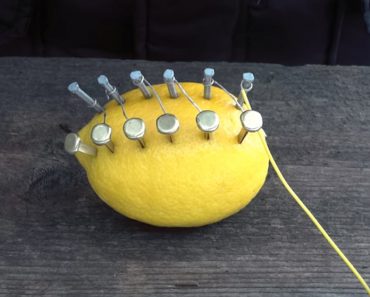
ADVERTISEMENT
Have you ever wondered what happens when you hammer a few nails into a lemon? It might sound like an odd experiment, but the results are nothing short of fascinating. In this article, we’ll delve into the science behind this peculiar activity, explore the step-by-step process, and discuss the practical applications and variations of the experiment.
A. The Intriguing Experiment
Picture this: you grab a lemon from your kitchen, a handful of nails, and a hammer. What happens when you combine these seemingly unrelated items? The answer lies in a captivating experiment that has intrigued both science enthusiasts and curious minds.
B. The Science Behind It
Before we dive into the how-to guide, let’s understand the science at play. This experiment involves a chemical reaction triggered by the acidic nature of lemons, creating a unique set of circumstances that leads to unexpected outcomes.
II. Materials Needed
A. List of Materials
To conduct this experiment, you’ll need a fresh lemon, several nails, and a hammer. The simplicity of these items makes this experiment accessible for anyone interested in trying it out.
B. Accessibility of Items
Worried about finding these items? Rest assured; they are readily available in most households. No need for special equipment or hard-to-find components – just a lemon, nails, and a hammer.
III. Step-by-Step Guide
A. Nailing the Lemon
Carefully hammer the nails into the lemon’s skin. The number and placement of the nails will influence the experiment’s outcome. Get creative and try different arrangements.
B. Observing the Changes
Once the nails are securely in place, observe the lemon over time. You’ll notice intriguing transformations, and the reasons behind these changes are rooted in basic chemistry.
IV. Scientific Explanation
A. Acidic Reaction
Lemons are known for their acidity, which plays a crucial role in this experiment. The acid reacts with the metal in the nails, leading to a series of chemical reactions that create unique visual effects.
B. Electrolysis Process
The presence of moisture in the lemon enhances the electrolysis process, amplifying the reactions between the acidic lemon juice and the metal in the nails. This interaction results in a visually captivating display.
V. Practical Applications
A. Alternative Energy Source
The experiment’s principles can be applied to understand basic concepts of alternative energy sources, making it a valuable educational tool for exploring environmental topics.
B. Educational Experiments
Teachers can incorporate this experiment into their lessons to engage students in hands-on learning, making science more accessible and enjoyable.
VI. Safety Precautions
A. Handling Tools Responsibly
While this experiment is generally safe, it involves the use of tools. Ensure proper safety precautions, such as wearing safety goggles and handling the hammer responsibly.
B. Supervising Children
If conducting the experiment with children, adult supervision is essential to prevent accidents and promote a safe learning environment.
VII. Common Misconceptions
A. Debunking Myths About the Experiment
Addressing common misconceptions about the experiment helps dispel any doubts or fears, encouraging more people to try it for themselves.
B. Addressing Safety Concerns
Some may worry about potential risks. By addressing safety concerns directly, we can reassure readers about the experiment’s safety when conducted responsibly.
VIII. Variations of the Experiment
A. Trying Different Fruits
Curious minds can explore variations by trying this experiment with different fruits, uncovering how acidity levels impact the reactions.
B. Exploring Diverse Materials
Don’t limit yourself to nails – experiment with various metals to observe how different materials influence the outcome.
IX. Historical Perspective
A. Origin of the Experiment
Discover the historical roots of this experiment, tracing its origins and evolution over time.
B. Evolution Over Time
As with any scientific curiosity, the experiment has likely evolved. Exploring its history adds depth to the overall narrative.
X. Impact on Popular Culture
A. Social Media Trends
Explore how this simple experiment has become a sensation on social media platforms, captivating audiences worldwide.
B. Viral Sensations
Highlight instances where individuals or communities have turned this experiment into a viral sensation, showcasing the power of curiosity and creativity.
XI. Environmental Considerations
A. Biodegradability of Materials
Consider the environmental impact of the materials used in the experiment. Are there eco-friendly alternatives to reduce our carbon footprint?
B. Eco-Friendly Alternatives
Suggest alternative materials that align with eco-conscious practices, promoting sustainability.
XII. DIY Projects
A. Incorporating the Lemon Experiment
Integrate the lemon experiment into DIY projects, sparking creativity and offering a unique twist to traditional crafting.
B. Combining with Other Household Items
Experiment with combining the lemon experiment with other household items, discovering new and exciting results.
XIII. Expert Opinions
A. Scientists’ Views on the Experiment
Gather insights from scientists who can provide a deeper understanding of the experiment’s scientific implications.
B. Educational Community Feedback
Explore feedback from educators who have incorporated this experiment into their teaching methods, highlighting its effectiveness as a learning tool.
XIV. Challenges and Limitations
A. Addressing Potential Issues
Discuss potential challenges that individuals may face when attempting this experiment and provide solutions to overcome them.
B. Overcoming Obstacles
Highlight stories of individuals who overcame obstacles during the experiment, showcasing the resilience of curiosity.
ADVERTISEMENT
XV. Conclusion
A. Recap of Key Points
Summarize the key takeaways from the article, emphasizing the excitement and educational value of the experiment.
Leave a Reply